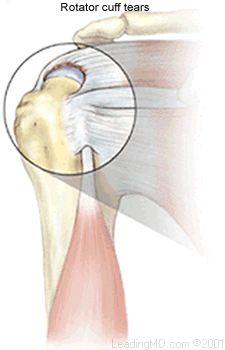
 |
|

Shoulder injuries are common in both young,
athletic people and the aging population. In each of these age groups,
there are numerous causes of shoulder pain. Two of the most common
problems occur in the narrow space between the bones of the shoulder.
Irritation in this area may lead to a pinching condition called impingement
syndrome, or damage to the tendons known as a rotator cuff
tear. These two problems can exist separately or together. It
is likely that rotator cuff tears are the result of impingement syndrome
and age related changes within the rotator cuff tendons.
What
does the inside of the shoulder look like?
The shoulder is the most mobile joint in the human body, with a
complex arrangement of structures working together to provide the
movement necessary for daily life. Unfortunately, this great mobility
comes at the expense of stability. Several bones and a network of soft
tissue structures (ligaments, tendons, and muscles), work together
to produce shoulder movement. They interact to keep the joint in
place while it moves through extreme ranges of motion. Each of these
structures makes an important contribution to shoulder movement
and stability. Certain work or sports activities can put great demands
upon the shoulder, and injury can occur when the limits of movement
are exceeded and/or the individual structures are overloaded.
Click here to read more about shoulder
structure
What is impingement syndrome?
Shoulder impingement syndrome occurs when the tendons of the
rotator cuff and the subacromial bursa are pinched in the
narrow space beneath the acromion. This causes the tendons and bursa
to become inflamed and swollen. This pinching is worse when the arm
is raised away from the side of the body. Impingement may develop
over time as a result of a minor injury, or as a result of repetitive
motions that lead to inflammation in the bursa.
Particular shapes of the acromion may make certain individuals more
susceptible to impingement problems between the acromion and the bursa.
With age and the onset of arthritis, the acromion may develop bone
spurs that further narrow this space. Impingement caused by bone spurs
on the acromion is common in older patients who participate in sports
or work activities that require overhead positions. Spurs may also
result if one of the ligaments in the coracoacromial arch becomes
calcified.
Impingement is classified in three grades:
-
Grade I
is marked by inflammation of the bursa and tendons
-
Grade II
has progressive thickening and scarring of the bursa
-
Grade III
occurs when rotator cuff degeneration and tears are evident
What is a rotator
cuff tear?
Continual irritation to the bursa and rotator cuff tendons can lead
to deterioration and tearing of the rotator cuff tendons. The tendon
of the supraspinatus muscle is the most commonly involved
tendon among the rotator cuff muscles. This muscle forms the top
of the cuff and lies in the narrow space beneath the acromion. It
is subject to the most pinching of all the rotator cuff muscles.
Rotator cuff tears can be the result of a traumatic injury or deterioration
over time. Symptoms may be present, but in many cases, the patient
experiences no symptoms at all. In young active people, full thickness
rotator cuff tears are fairly uncommon. When they do occur, they
are usually the result of a high-energy injury to the rotator cuff
that is associated with throwing or overhead sporting activities.
In older people, rotator cuff tears tend to be the result of wear
and tear over time. Several scientific studies have shown that up
to 2/3 of the population at age 70 have rotator cuff tears; many
of these people had no symptoms.
|

